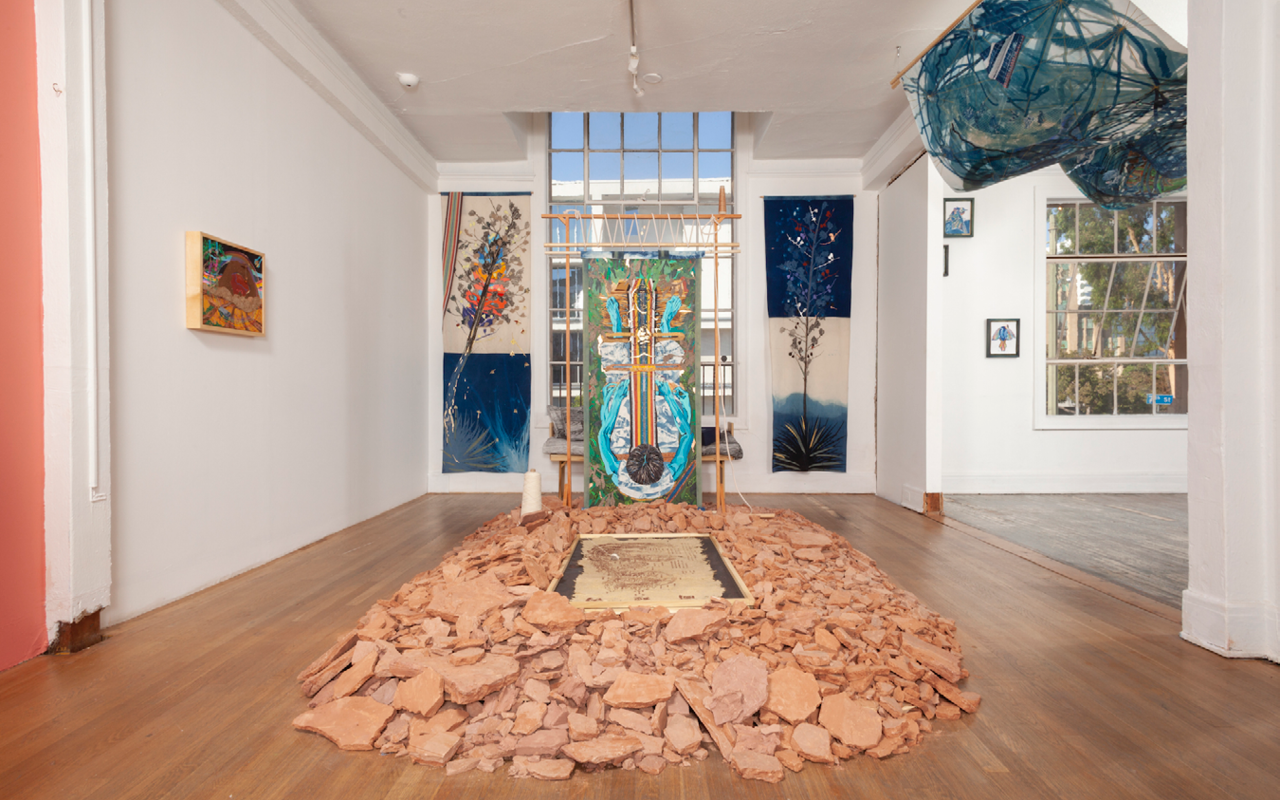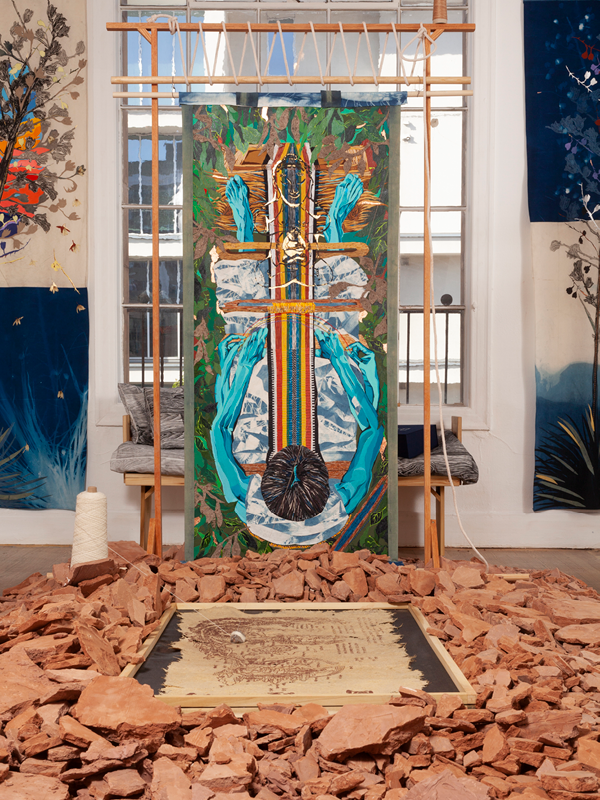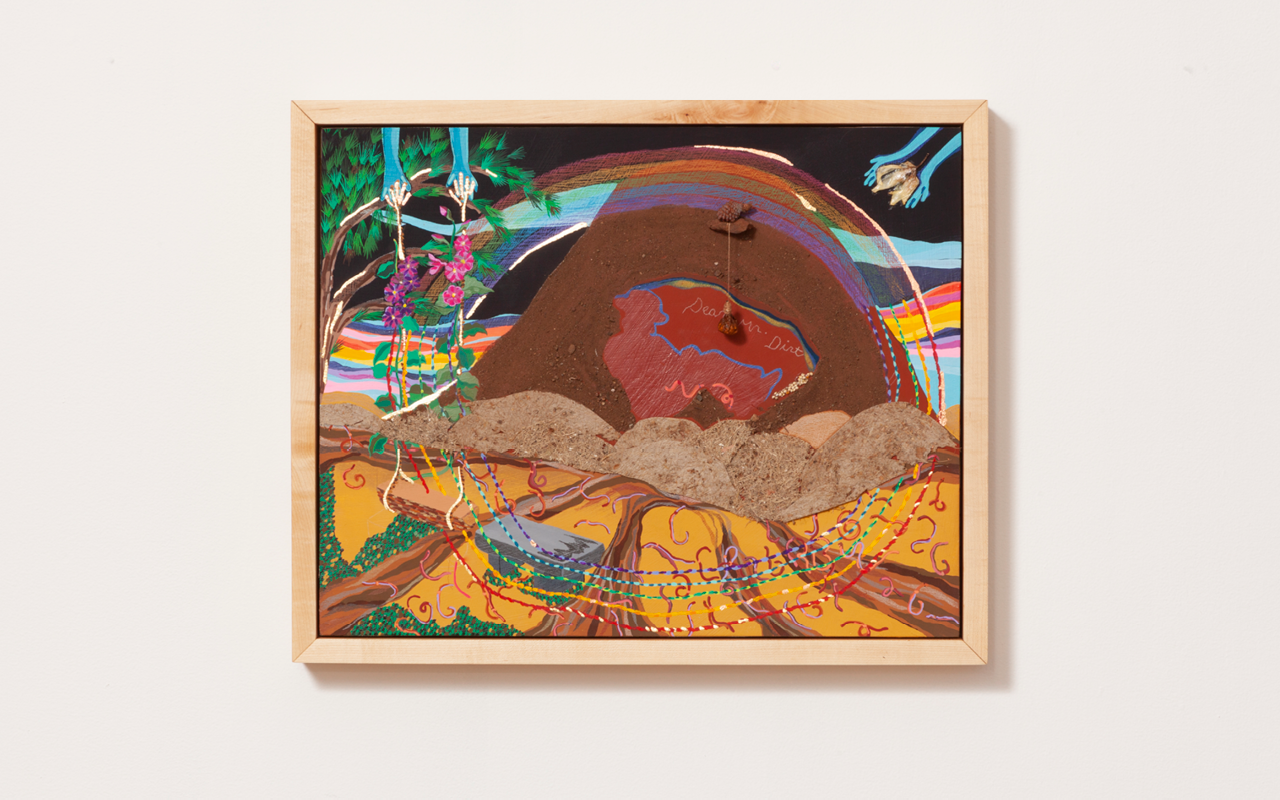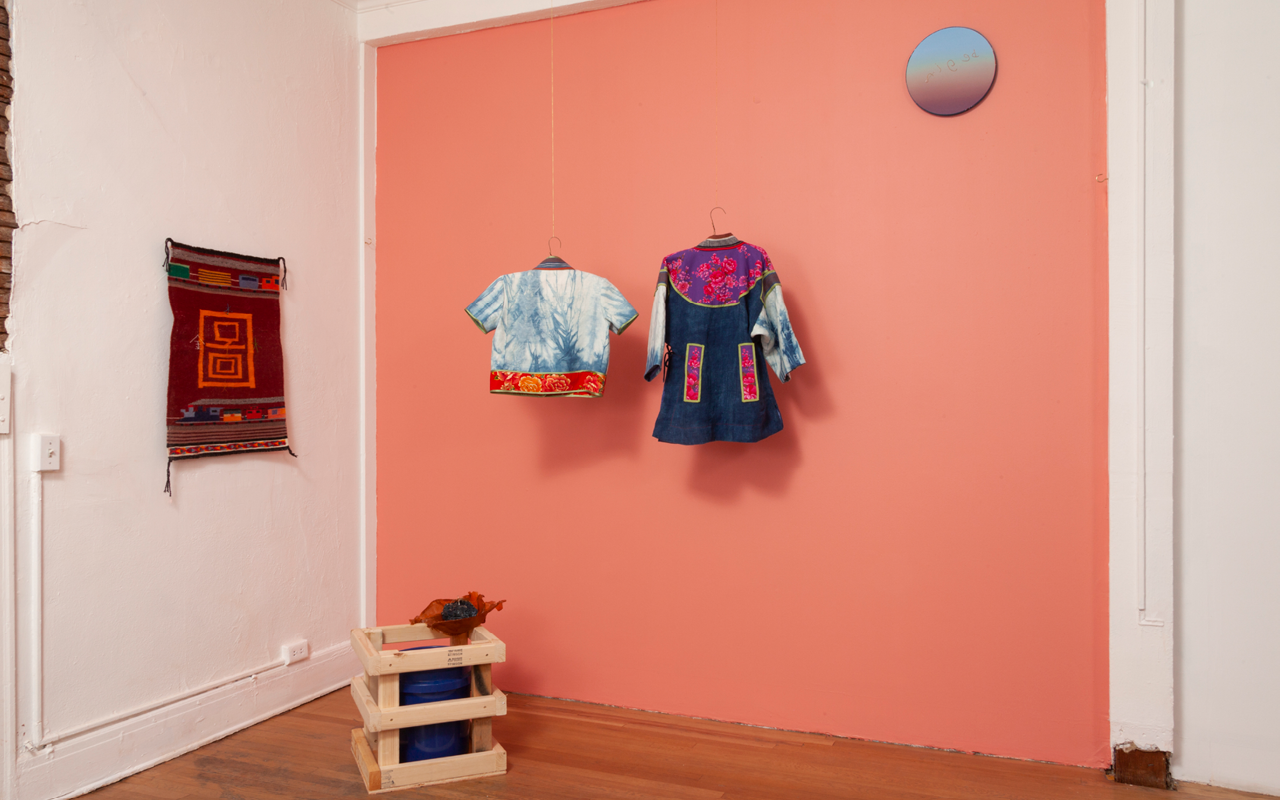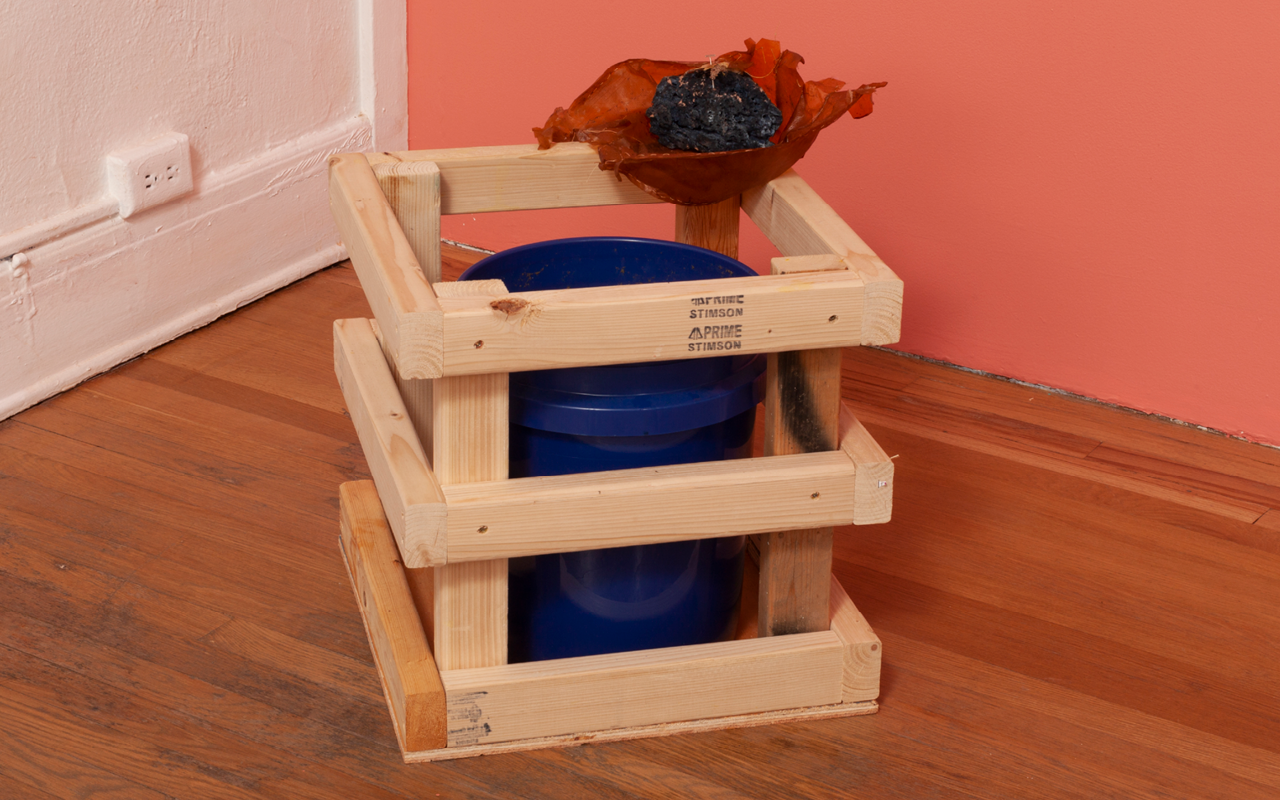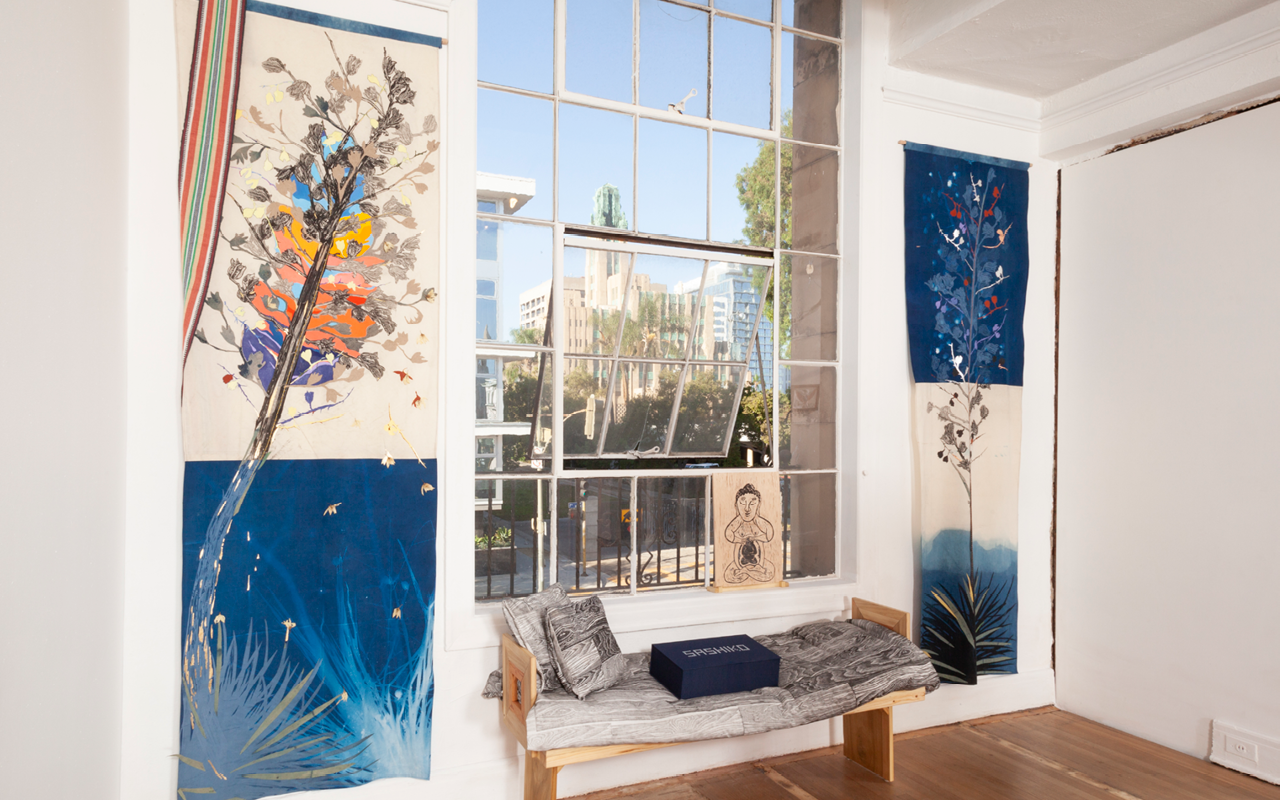iris yirei hu
hands are full blue
September 21 - October 26, 2019It begins with the dead. There is a Hmong understanding that when one dies, the soul of the dead will return to their birthplace to find her placenta buried beneath the earth, where her mother had kept it. The soul will wear the placenta, like a jacket, and dwell.
Dwelling is both a movement and affective principle in hu’s work. Often situated in personal, historic, and environmental loss, hu’s work is a living document of grief. Mourning and reflection illuminate the entangled interdependencies and collaborations that allow her to make life in a precarious world. Without memory, stories become harder to tell.
hands are full blue is a rhizomatic assemblage that tells stories of an entangled world, while considering the site-specific history and community of Visitor Welcome Center. The crux of hu’s practice involves collaborating with those around her, including plants, people, and landscapes. In her second project with the gallery, hu builds with the works in the exhibitions prior to hers—the clay floor piece by Armando Cortes and Hande Sever’s soybeans—and uses weaving as a conceptual framework and practice to unearth loss and expose the intimacy between seemingly unconnected things.
The central installation, atop the remains of Cortes’ floor, shows a figure weaving with a traditional Atayal floor loom among camphor leaves. Framed in a Navajo loom, the artist brings together the two indigenous weaving practices, both of which the artist has studied. In 2017, hu began apprenticing with Melissa Cody, fourth-generation Navajo weaver and artist from No Water Mesa, Arizona. Earlier this year, hu returned to her family’s home in Taiwan to study Atayal weaving with Ms. Sayun Zhou in Taipei’s Wulai Mountains. Weaving requires fibers, and fibers require landscapes—i.e. plants for dye, sheep for wool—and they connect people, places, pasts, and futures. For hu, weaving an image is a manifestation of a community and cosmology at work, unsettling the myth of the individual by shifting our attention to how things are related.
Camphor trees were once one of Taiwan’s major exports, and a contentious resource among the Chinese, British, Americans, and Japanese. The tree has a variety of uses, but perhaps most importantly as an ingredient in gunpowder and celluloid. Celluloid, a thermoplastic, was invented between 1856 and 1869, and by 1889, was used to make photos and films. Hollywood motion pictures were recorded on celluloid film until it was phased out in the mid-20th century. When Japan officially colonized Taiwan in 1895, it monopolized the camphor industry and banned the practice of weaving and other forms of sustenance in order to ensure that the Taiwanese indigenous labored the camphor and rice plantations. Within the same time period across the Pacific, in the name of Manifest Destiny and ethnic cleansing, the U.S. government forcibly removed the Navajo people from their ancestral homelands and massacred their livestock. This tragedy, marked as the Long Walk to Bosque Redondo, a 40-square mile deportation camp in New Mexico, gravely impacted Navajo weaving.
The new transcontinental railway system ushered in aniline dyed yarns milled in Germantown, Pennsylvania. New colors and patterns emerged from forced relocations, notably the iconic Navajo “eyedazzler.” Cody taught hu to weave with Germantown yarns, and in this project, hu uses the material to allude to competition for land, trade, and world domination. The reality and myth of the American West is inscribed with Germantown yarns and also with Taiwan’s plant life, collapsing the distance between Taiwan and the U.S. through intimately intertwined fibers and hands. hu urges us to recognize that liberty and progress is a perpetual acquirement of loss. She sees loss most evident in weaving, where legacies of coerced labor, attempted genocide, and transformation are expelled from the looms and fibers themselves.
A stele diagram found in the late 19th century in Southern China, the Neijing Tu(Chart of the Inner Warp), describes the micro and macrocosmic connections between human, landscape, and the universe through the cultivation of qi. In it, a weaver girl spins silk, which may be a metaphor for the nebulous qi. Printed atop hand processed wild oat paper, the tuis a guide towards rehabilitation. Honoring her dependence on the natural elements, hu dances with and relies on the Sun each day to make her work —tracing shadows, painting, drying handmade paper and textiles. A collaboration with New Mexico based artist, Paula Wilson, culminates in two large yucca prints and a handmade daybed. Printed, sewn, dyed, and painted, the two artists each have an innate attraction to the yucca of her environment—the New Mexican yucca for Wilson and the chaparral for hu—and each plant’s symbiotic relationship with its moth pollinator. Their growing friendship is a reflection of this symbiosis, and the taxonomy of and geographical distance between the two yuccas point to the politicized history of the American West. Between the prints, a daybed offers a space for reflection and learning, as it houses a book by the late writer emi kuriyama, who was hu’s collaborator and friend, and whose legacy lives through Visitor Welcome Center.
More information regarding emi’s book, sashiko, designed and published by Chicago based press Candor Arts, and details on the emi kuriyama spirit award, an accompanying direct artist and writer grant, are forthcoming.
This exhibition is made possible through the Foundation of Contemporary Arts Emergency Grant and the Paul & Daisy Soros Fellows Association.
iris yirei hu (b. 1991, Los Angeles, CA) is an artist who works in painting, fibers, text, and installation. Her work requires collaborating with others. She is interested in how people, places, and things are related, and sees weaving and craft practices as a manifestation of entangled interdependencies. Her work centers learning as a method of engagement, and is both research based and dependent on lived experience. She has shown her work at the Los Angeles Contemporary Exhibitions (LACE), Occidental College, John Michael Kohler Arts Center (Sheboygan, WI), Los Angeles Municipal Art Gallery, Women's Center for Creative Work, Human Resources, Lenfest Center for the Arts (New York, NY), Commonwealth & Council, and Visitor Welcome Center. Her work has been reviewed and featured in the LA Times, Carla, CNN, Sinovision, KCET, X-TRA Online, and Artillery. She has been supported by the Paul & Daisy Soros Fellowship, Foundation for Contemporary Art, Rema Hort Mann Foundation, among others. BA from UCLA, MFA from Columbia University.
